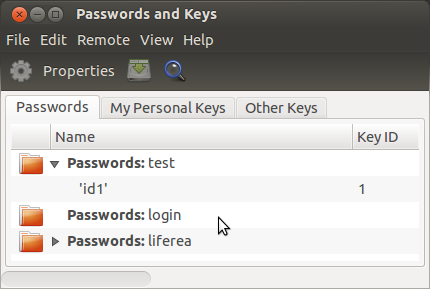Since GTK+ 3.0 and the broad introduction of GObject Introspection (GIR) one now can switch from using the existing
GnomeKeyring Python module to direct GIR-based access. This allows reducing the Python runtime dependency. Below you find a simple keyring access script unlocking a keyring named "test" adding a new entry and dumping all entries in the keyring. This code uses the generic secret keyring type and was originally written for a
Liferea plugin that allows
Liferea to store feed passwords into GnomeKeyring:
from gi.repository import GObject
from gi.repository import GnomeKeyring
keyringName = 'test'
def unlock():
print 'Unlocking keyring %s...' % keyringName
GnomeKeyring.unlock_sync(keyringName, None)
def dump_all():
print "Dump all keyring entries..."
(result, ids) = GnomeKeyring.list_item_ids_sync(keyringName)
for id in ids:
(result, item) = GnomeKeyring.item_get_info_sync(keyringName, id)
if result != GnomeKeyring.Result.OK:
print '%s is locked!' % (id)
else:
print ' => %s = %s' % (item.get_display_name(), item.get_secret())
def do_query(id):
print 'Fetch secret for id %s' % id
attrs = GnomeKeyring.Attribute.list_new()
GnomeKeyring.Attribute.list_append_string(attrs, 'id', id)
result, value = GnomeKeyring.find_items_sync(GnomeKeyring.ItemType.GENERIC_SECRET, attrs)
if result != GnomeKeyring.Result.OK:
return
print ' => password %s = %s' % (id, value[0].secret)
print ' keyring id = %s' % value[0].item_id
def do_store(id, username, password):
print 'Adding keyring entry for id %s' % id
GnomeKeyring.create_sync(keyringName, None)
attrs = GnomeKeyring.Attribute.list_new()
GnomeKeyring.Attribute.list_append_string(attrs, 'id', id)
GnomeKeyring.item_create_sync(keyringName, GnomeKeyring.ItemType.GENERIC_SECRET, repr(id), attrs, '@@@'.join([username, password]), True)
print ' => Stored.'
# Our test code...
unlock()
dump_all()
do_store('id1', 'User1', 'Password1')
do_query('id1')
dump_all()
For simplicity the username and password are stored together as the secret token separated by "@@@". According to the documentation it should be possible to store them separately, but given my limited Python knowledge and the
missing GIR documentation made me use this simple method. If I find a better way I'll update this post. If you know how to improve the code please post a comment! The code should raise a keyring password dialog when run for the first time in the session and give an output similar to this:
Unlocking keyring test...
Dump all keyring entries...
=> 'id1' = TestA@@@PassA
Adding keyring entry for id id1
=> Stored.
Fetch secret for id id1
=> password id1 = TestA@@@PassA
keyring id = 1
Dump all keyring entries...
=> 'id1' = TestA@@@PassA
You can also check the keyring contents using the
seahorse GUI where you should see the "test" keyring with an entry with id "1" as in the screenshot below.

